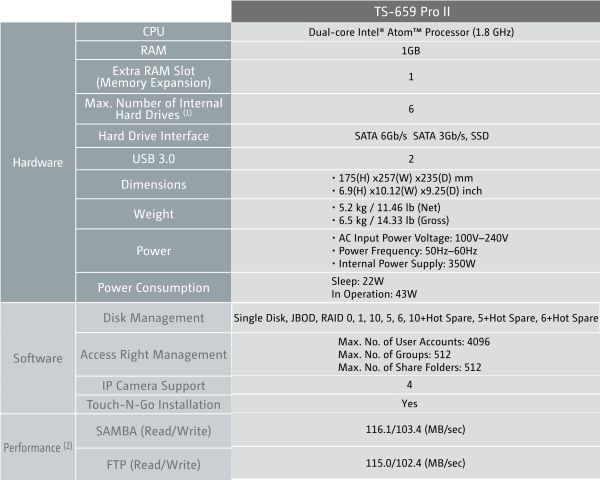QNAP TS-659 Pro II Review
by Ganesh T S on September 19, 2011 8:00 AM EST- Posted in
- IT Computing
- NAS
- QNAP
QNAP is a well known player in the SMB / SOHO NAS market. This market is a highly competitive one with many players like Synology, Thecus, Netgear, LaCie, Sagate and Western Digital. Consumers with a necessity to store and backup their home media collection also form a small segment of this market.
We have been playing around with the QNAP TS-659 Pro II unit over the last month or so. Based on the Intel Atom D525 platform, it has 6 bays and dual GbE ports, making it a candidate for the high end SMB market. The Pro II units introduced this year have a couple of USB 3.0 ports which the versions from the last year lacked.
The purpose of any NAS is to serve as a centralized repository for data while also having some sort of redundancy built in. The redundancy helps in data recovery, in case of media failure of any other unforeseen circumstances. In addition to the standard RAID levels, some companies also offer custom redundancy solutions. The OS on the NAS also varies across vendors.
The QNAP TS-659 Pro II runs a Linux variant (Turbo NAS v3.5 was used in our benchmarks) which can be managed through a web browser. Internally, the dual core Atom D525 runs at 1.8 GHz and has four execution threads, thanks to the hyper threading feature. There is 1 GB of RAM inbuilt, but it is possible for the end user to increase this. The dual GbE ports can be configured in multiple ways to provide load balancing or fault tolerance or just dynamically aggregating the bandwidth.
Let us conclude this section with a look at the marketing specs from QNAP:












69 Comments
View All Comments
jmelgaard - Monday, September 19, 2011 - link
I Use the PS3 Media Server instead of the built-in one to stream to a PS3.I must admit I have not tried streaming directly to my Sony DLNA enabled TV as I have gotten to use to using the PS3.
But it might be worth trying to see if it narrows the cases where the format is unsupported.
saiga6360 - Monday, September 19, 2011 - link
You will probably run into the same issue, which is really a Sony issue not supporting media formats. In which case, you will be stuck with a PC in between your storage and media player. As NAS hardware continue to upgrade to more powerful CPUs then maybe a better integrated DLNA media server can become possible.jmelgaard - Tuesday, September 20, 2011 - link
The point is that the PS3 has the same issue, many formats are unsupported by the PS3.The PS3 media server is therefore aimed to transcode unsupported medias to a format that the PS3 supports, so this should narrow the cases unless it chooses to transcode into a format that a TV does not support.
There is a bunch of settings for the various encoders, but to what degree you can control what is transcoded by default and what the output is I don't know.
jmelgaard - Tuesday, September 20, 2011 - link
Oh and the whole point of choosing the PS3 media server over any others was just that it already has a Pre-build QPKG for QNAP users making the installation a blizz...For other NAS types it's a different story.
jwcalla - Monday, September 19, 2011 - link
I'm somewhat surprised by the (relatively) poor NFS performance. Were the hard disks left in ext4 configuration or formatted to NTFS before the tests?ganeshts - Monday, September 19, 2011 - link
NFS performance could be improved by playing around with the mount options. We just tabulated the values at the default settings. The disks were in EXT4 only.Sivar - Monday, September 19, 2011 - link
A know of several businesses looking for something just like this. Your article was not only well-written and informative, you also have a clue about image formats so didn't use JPEG, which is horribly inefficient for screen shots like the ones in the article.SeeManRun - Monday, September 19, 2011 - link
Hi Ganesh,I read the article as I am very interested in getting a NAS or building my own. One thing that appears to be a limit for all of these machines is the speed at which you can transfer data from them. It seems to me with dual gigabit ethernet ports bonded, you should be able to see above 110 megabytes per second. I have read on smallnetbuilder that almost no NAS can get above this limit. Do you happen to know why, or care to explore this?
Thanks
tbutler - Monday, September 19, 2011 - link
Question that wasn't answered in the review: are the eSATA ports on this box compatible with port multipliers?ganeshts - Monday, September 19, 2011 - link
Thanks for bringing this to my attention.I just checked it out myself and am able to confirm that the eSATA ports are compatible with port multipliers.